| Look at this beautifully decorated saxophone. Note the micro tuner on the neck. | The side keys, and right table boast mother of pearl inlays. |
| Look at this beautifully decorated saxophone. Note the micro tuner on the neck. | The side keys, and right table boast mother of pearl inlays. |
| The palm keys, and the left hand table also have pearl inlay ! | Pretty much the entire exposed instrument surface has ornate encgraving. |
| Imagine the time and patience to hand engrave this instrument. | Another view of the awesome artwork of this era. |
| More ornate designs adorn the bell and bow of this instrument. | The "portrait" area of this particular "Lady Face" sax, is adorned with a Cherub. |
Never an official Conn designation, "Big Bore" is a nickname used by players for Conn's saxes of the era, and describes the wider dimensions of these insturments, compared to earlier models mady by Conn and other Manufacturers.
This particular instrument is gold plated. It is my believe that most (if not all) of the "Lady Face" saxophones were also gold plated.
The "Lady Face" model should not be confused with the famous Conn 6M alto, commonly refered to as the "Naked Lady" Conn. This model also had an image of a ladies face and shoulders engraved on the bell. While the 6M is a famous, and desirable instrument for most players - - it was a far less ornate, and a more "common" offering of the Conn Saxophone family.
This is a full metal oboe. As the "nameplate" in the case indicates - - it was made by "Kohlert's Sons" of Czechoslovakia.
Made by Kohlert's Sons is different from the "Kohlert and Sons" line of clarinets and oboes, that most of us are familiar with.
This particular instrument has a couple of key portions missing. But they could be fabricated, if desired.| A gold washed bell leads the show of this piece of art. | Intricat engraving, with gold inlay adorn the bell. |
This is the famous King Silver Tone Trpt. It was manufactered in the early 30's. This instrument is the "little brother" to the King Silver Tone Tombone, of the same era.
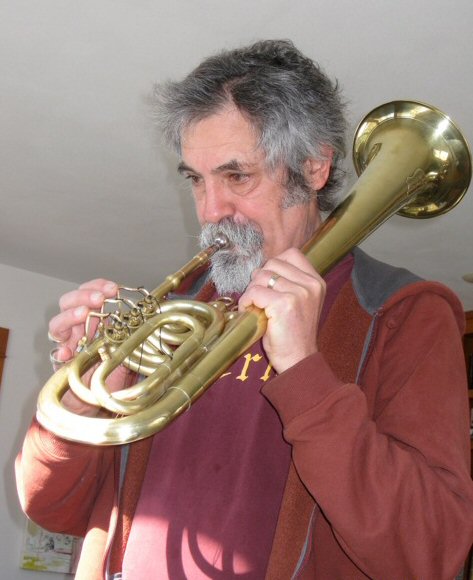
| 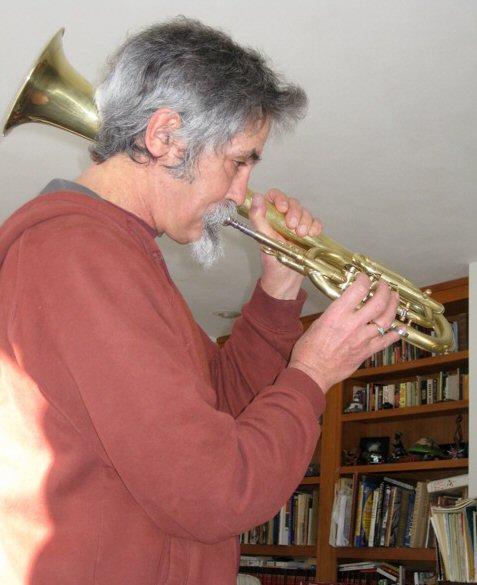 |
| Klaus Thomas Asher playing one of his prized instruments. | Another view of Klaus playing his saxhorn. |
"This is an early saxhorn by John Stratton, probably close to 1850. His later horns had more ornamentation. His craftsmanship, at that time, was (based) in New York. This instrument is in the key of Eb. Between the trumpet and the trombone pitch.
One personal note, regarding Klaus Thomas (or Tom to his friends) Asher. As far as we (at S.I.R.) are concerned - - he is THE "go to guy" in the southern Wisconsin, and northern Illinois area, for orchestral string concerns.
He doesn't just repair them - - - he can BUILD them too!
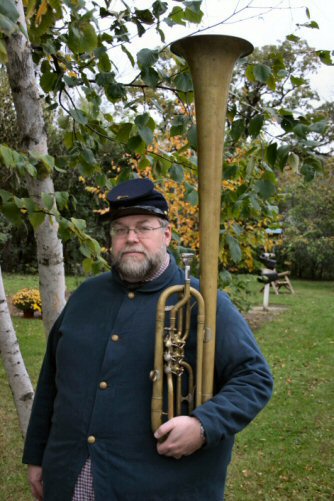
|  |
| Pre Cival War Saxhorn. | Saxhorn in playing position. |
This particular instrument is played on a regular basis with the Regimental Volunteer Band of Wisconsin. This group was organized in 1993. The organization is based out of Whitewater Wisconsin, and participates in period concerts, and re-enactments throughout their regional area.
Rusty Ayers joined the group in 1994 and began a search for his own saxhorn. He was soon able to purchase this instrument from an individual in California. It was then restored by Carl Thacker of Carl's Pro Band Repair ( http://www.carlsproband.com) in Bloomington, Illinois.
We were able to assist Rusty with his saxhorn after a little "mishap" and some good ol' "upkeep" that all instruments seem to need, from time to time - - no matter their age.
We recieved the following information from Mr. Jim Cathey, regarding an instrument that seemed worthy of our "Stange Page".
Thanks Jim, for your contribution.
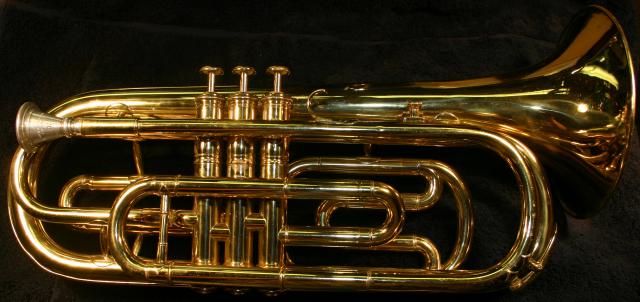
Bass Trumpet? Besson & Co. "Prototype", England. Imported by C. Fischer. No discernible serial or model numbers. Very good condition, no significant dents and very good lacquer. I bought this from a guy on Craigslist who wasn't exactly sure what it was, he'd thought it was a bass trumpet but it looked too short to me, and the double-bend tuning slide makes me think of an Eb/F horn. [Nah, that's in the third valve slide, not in the main path. Interestingly, that slide has a faux bow across its end.] He'd bought a Bach 9AT mouthpiece for it, which didn't fit at all (that's what he was selling that I'd wanted in the first place, for the Frumpet). He'd paid $75 for the horn some time ago, I paid him $125. (I'd started watching for affordable bass trumpets recently, but I figured I'd have to look for possibly years before I found one with my name on it. [I was not keen on a Chinese rotary-valve TSO, though at a good-enough price I might have gone that way.] Instead I practically tripped over this one, and then only because I'd asked what he'd bought the 9AT for.) It had come from an estate sale via a friend of his, where it was probably separated from any additional tuning crook, its (very odd?) mouthpiece (or adapter), and case. I imagined it was probably worth what I was paying for it, so I didn't feel too bad about gambling. The mouthpiece receiver is substantially inset (about 3.5 inches), and at 0.490" much larger than usual for a trumpet; not even our trombone mouthpiece (which I'd brought along) fit it. At home I was able to fit the larger of the two euphonium mouthpieces (the White 28) in the receiver though it went in all the way up to the end of its taper and even so was still a bit loose, and you also had to twist the horn sideways to have the main bow miss your chin while playing. Something's not right! But when I played into the tuner it was in Bb. So, it's either a bass trumpet, or some kind of marching valve trombone or baritone. (Honestly, it looks more like some kind of bass cornet to me, or perhaps a pocket valve trombone!) It has a 6.5" bell, and a 0.480" interior diameter at the main tuning slide. I used a cloth tape measure to determine the length of the tubing and came up with just about 9'. Those dimensions just scream Bb bass trumpet to me. Overall it's about 18" long.
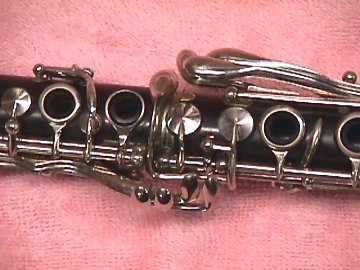 | 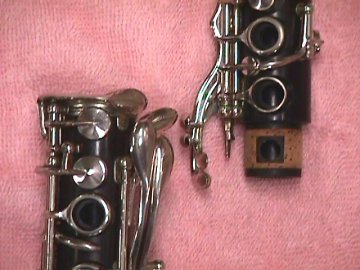 |
||
| The "different" location of the G# tone hole necessitates a hole being drilled through the actual tenon of the top joint. | |
So your standing around with a group of musicians, or maybe some fellow repair techs., and someone mentions a clarinet with an "articulated G#". You "nod knowingly" and in your mind are asking yourself, "What the heck is an articulated G#?"
Well - - this is it. The "natural" position for the G# tone hole (in the air column) is halfway between the "G" and the "A" tone holes. This position is right in the way of the tenon, however. It is a lot of extra trouble to manufacture, and to maintain. (It can be a lot of fun installing a new tenon cork on one of these instruments.) With the hole being located in the tenon, this area is also a little "weaker" than if it were a solid tenon.
Therefore, the hole is normally moved a little "higher", and then the diameter of the hole is adjusted to compensate for the re-positioning in the air column. The final result is not quite as "pure" of a note as if it were back in it's "natural" position - - but the advantages out way the minor differences.

One day we knocked most of the dents out of one of them, and got out the paint can. This one shows the colors of our local high school.
We have a few other cornets that we hope to give a "new identity" later this summer. If you have a special request for the color(s) for one of them - - drop us a line at sir@jvlnet.com While we can make no promises, all recommendations will have consideration.
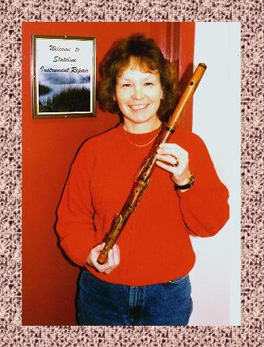 | 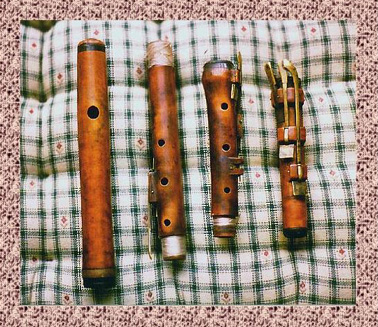 |
||
| A closer look. | |
Mr. David Shorey (an expert concerning antique flutes) was kind enough to research this Muller flute for us. It is believed to have been made in Germany, circa 1830. This instument is made of "Box Wood" and demonstrates some of the first attempts at establishing a key mechanism for the instrument, that we know as a flute today.
| Playing position - standing. | Playing position - seated. |
This "King" tuba was manufactured by the H.N. White Co. It has the serial number 96069. The instrument is 88" tall. (No, it DID NOT fit under the 7 foot ceiling, that is in our business building.) It is fitted with two permanent lead pipes. A rotor valve changes from one lead pipe, to the other. (Note the "lower" pipe that is just above the musician's right hand, in the "standing" picture. Also, the lead pipe that is near his mouth. / In the "seated" picture, the "upper" lead pipe almost looks like a bell connector ring.)
Thanks to Lou Long of Rockford, IL . . . for permission to photograph, and display this instrument.)
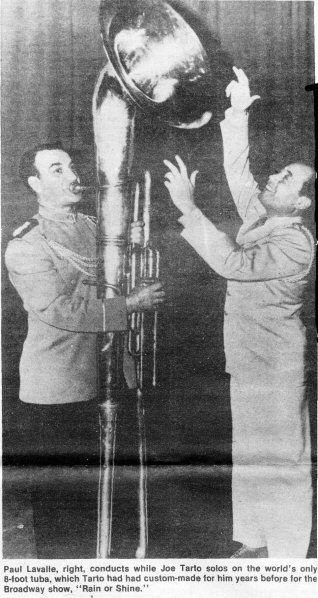
| We recently recieved additional information about this instrument. It was provided by Mr Bryan MacMartin, of New Orleans, LA. Mr. MacMartin wrote. "I came across the 8 foot tuba on you "Strange" page and recognized it! I think at one time I had bought a piece of sheet music on eBay that showed a picture of Joe Tarto and his
8 foot tuba! I seem to remember the "title" "Titan of the Tuba" on the picture and it may have been sheet music for the Broadway show "Rain or Shine". .... Been a few yeas since I laid eyes on it..... I believe (it's) ONE OF A KIND!"
Thanks Bryan, for your valued contribution to our web site. It's pretty neet to find that we have had a "one of a kind" piece of history in our facility. |
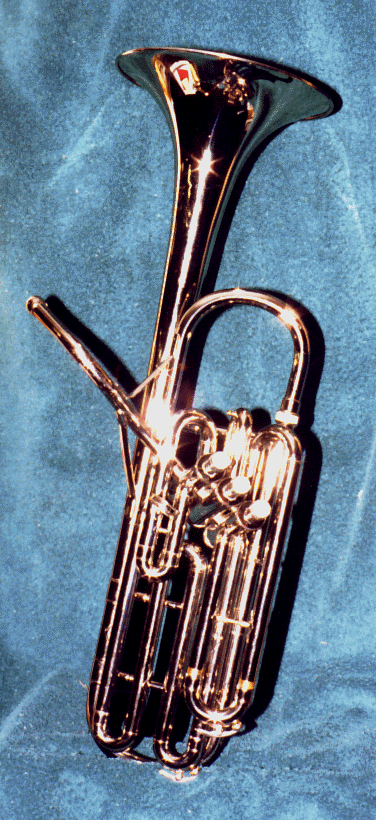
| This is the perfect answer for those musicians who like the trombone sound but not the "stretch". It's even more compact than the regular "valve 'bone". (And you sure can't beat the mint condition of this Olds trombonium, serial #N37351.
Thanks to Paul Wright of Rockford, IL . . . for permission to photograph, and display this instrument.) |
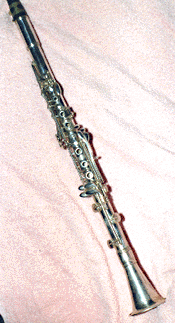 | 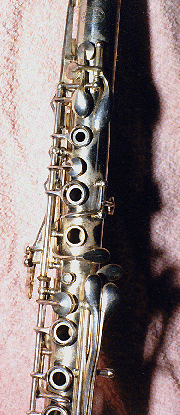 |
||
| "Double Wall" metal clarinet. | A closer look. |
This clarinet has been in the family of it's owner, since it was new. It is thought to have been an experimental model, and was manufactured by the Triebert Co., in Paris France. There is no identifiable serial, or model number on the instrument. The clarinet owner's grandfather, purchased the instrument (new) while in Paris, in the late 1800's.
Thanks to Pat Hooper (retired Band Director from Prairie Hill School, South Beloit, IL.) for making this instrument available for display.
Remember the "double bell euphonium" that is mentioned in "The Music Man"? This is what one looks like.
This instrument is stamped "Buffet Crampon & Co. / Paris / Carl Fischer - New York / LP " There are no model, or serial numbers that are obvious. The instrument is "one piece" and measures approx. 14 3/4" long (without reed). The receiver accepts an oboe reed. (Sorry, for the limited time that it was available to me, I did not attempt to establish the "key" of the instrument.) Thanks to Lou Long of Rockford, IL . . . for permission to photograph, and display this instrument.)
EXTRA! EXTRA!
Mr. George Campbell was kind enough to drop us an e-mail, with the identity of this instrument. It is a Piccolo Oboe (key of F). Thanks for the help, Mr. Campbell!
We have also recieved the following:
Dear sir
"The Instrument identified in your unusual instruments page as "A Piccolo Oboe" is in fact a "Musette" in the key of F and based on the French Musette Bagpipe Chanter. These instruments were the toys of upper crust children in the 18th, 19th and early 20th cent.
A diagram of this Musette is shown in "Musical Instruments of the World" pg.51 and a precise paragraph on its measurements are listed in "Ancient European Musical Instruments" published by the Boston Museum of Fine Arts. Another source for replica plans can be found in Trevor Robinson's book "The Amateur Wind Instrument Maker.
Sincerely,
Thomas Hastay
Amateur Instrument maker."
Dear Stateline Repair,
Here I am adding to the 'un-identified' (well now identified) Musette. I am oboe player myself. The description of the musette being in the key of 'F' is in fact wrong! The musette is also called the Eb oboe, hence it is in Eb, as I have read in many books!
Thanks so much,
Melanie Rothman (Oboist)
Check back with us, for images of some of the more "unusual" and/or "unidentified" instruments that have come into our shop. If you have any information to add about them, or if you have any unusual images to add . . please let me know.
Copyright © 1997 Stateline Inst. Repair, Inc.
e-mail: statelinerepair77@gmail.com
This page last updated Thursday, May 4, 2017 1:57:26 PM